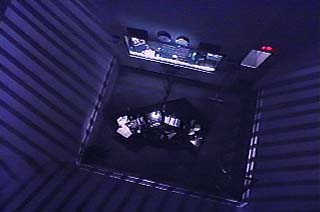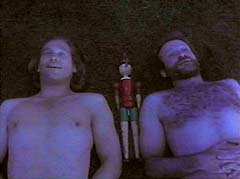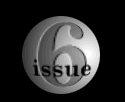|

This camera shot looks down on Jack's deejay booth
in The Fisher King.
In The Fisher King (1991), Jack’s deejay booth also resembles a cell, given that the lighting provides chiaroscuro shadows that streak down the walls and resemble jail cell bars. The psychiatric ward in 12 Monkeys (1995) was Gilliam’s latest depiction of entrapment. Even in his short film, The Crimson Permanent Assurance (1983), Gilliam turns the building housing the accounting firm into a huge slave ship, showing (for a brief moment) the old workers chained to the floor and forced to row (the rowing match-cut to the pulling of an old adding machine handle).
As in the above discussion concerning the past/future motif in Brazil, all these instances of imprisonment are not idle coincidences. Gilliam seems to be using these images of imprisonment to bring physicality to Max Weber’s theory of the "iron cage." Mike Featherstone outlines this theory in his "The Fate of Modernity: An Introduction":
Weber was deeply ambivalent about modernity and aware that its central dynamic, the process of rationalization, brought with it its own irrationalities: the triumph of zweckrationalitat on the societal level, which promised greater economic and administrative efficiency, was accompanied by the impersonality of the "iron cage" bureaucratic machine, which curbed individual freedom, while on the cultural level it led to the intellectualization and disenchantment of the world with a loss of meaning, to the irrationalities of value commitment without ultimate guidance and certainty. 16
Through his repetitious physical presentation of cages and such, Gilliam demonstrates how modernity psychologically traps the individual, and brings about a loss of meaning. Whether or not escape is possible from the "iron cage" is not determined.

Jeff Bridges and Robin Williams in the "naked in
Central Park" scene in The Fisher King.
Some of his films, Munchausen, for example, with its "open the gates!" ending, and The Fisher King, with its naked in Central Park, fireworks overhead ending, suggest humanity’s ability to deal with (if not overcome) modernity. However most of his movies, specifically Time Bandits, Brazil, and 12 Monkeys (and to a lesser degree, Jabberwocky), in which the protagonists become trapped in their own fantasy worlds (as the only option to the social world of modernity), offer no hope of escape.
Weber has a second affinity to Gilliam (or vice versa) dealing with modernity. To quote Weber: "Bureaucratic rationalization…revolutionizes with technical means…’from without’ — it first changes the material and the social orders and through them, the people, by changing the conditions of adaptation — by contrast, the power of charisma rests upon the belief in revelation and heroes…charismatic belief revolutionizes men ‘from within’ and shapes material and social conditions according to its revolutionary will."17 In Weber’s view, the technological world of modernity tries to eliminate any need for magic, fantasy, or any irrational forces.18 Gilliam presents this idea of change "from without" through certain aspects of his mise-en-scene. The large and ominous buildings in Brazil, for example, seem to engulf and stifle their human counterparts. In some respects, the external world tries to force control on the internal world of the mind.19

This camera shot from Brazil looks down on Sam as he
enters the Ministry of Information Retrieval.
Yet, there is a second part to Weber’s theory that Gilliam depends on. The protagonists in his work, through their belief in the power of dreams and fantasy ("from within," so to speak), reverse the process and try to change the external world. Sometimes they fail (Brazil) and sometimes they succeed (Munchausen).
Conclusion
Gilliam makes the point that every step forward can also be a step back. In other words, science, technology, reason, and logic may try to move humanity forward, but in the process they inevitably erode the traditional values that give human beings a sense of meaning in their lives.20 Gilliam represents this when he creates a world in which every element of progress seems to be just another element of the past (again, the past/future distinction from Brazil). For Gilliam, mise-en-scene is not just something a viewer sees but an entire philosophy that helps that viewer understand this modern world in all its complexities.
page 4 of 4
 
Keith James Hamel holds a Master's in Film Studies from Boston
University. He has taught at Boston University,
University of Massachusetts - Boston, and currently teaches at Suffolk
University. Mr. Hamel is assistant editor on a
forthcoming book on John Ford (with Dr. Gerald Peary). He can be reached at khamel@sprynet.com
© Keith James Hamel
photo credits: MCA Universal Home Video, Columbia TriStar Home Video
|




